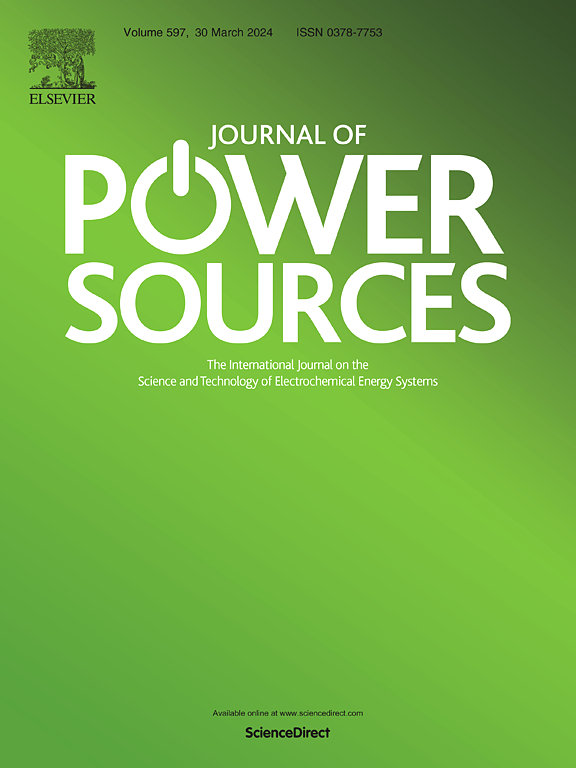Design of self-supporting porous soft-hard carbon hybrid materials for ultra-long cycling lithium-ion storage
IF 8.1
2区 工程技术
Q1 CHEMISTRY, PHYSICAL
引用次数: 0
Abstract
Hard carbon materials are of great interest for battery electrodes due to their affordability, extensive surface area, robust chemical resilience, and superior electrical conductivity. However, limitations in non-faradaic reaction mechanisms restrict lithium storage capacity. To achieve high energy density in hard carbon anodes, we employed pre-oxidized coal pitch, polymethyl methacrylate as a soft template, and polyacrylonitrile-assisted electrospinning to fabricate oxygen/nitrogen co-doped coal pitch-based carbon fibers (HSPCNF) featuring a multichannel structure. By precisely controlling precursor solution composition and carbonization temperature, we optimized the microstructure, yielding coexisting short-range ordered graphite microcrystals and disordered carbon, effectively enhancing electronic conductivity and lithium-ion diffusion. The multichannel structure significantly increases electrochemical active sites and facilitates electrolyte infiltration. HSPCNF-600 achieved a high initial reversible capacity of 1020.3 mAh g−1 at 0.1 A g−1. More notably, it maintains 97.7 % capacity after 2000 cycles at 1 A g−1 and delivers a considerable reversible capacity of 190.1 mAh g−1 with 93.4 % capacity retention even after 10000 cycles at 10 A g−1. This study provides a novel strategy for advanced anode material design and high-value utilization of coal-derived carbon.
超长循环锂离子存储用自支撑多孔软硬碳杂化材料的设计
硬碳材料由于其可负担性、广泛的表面积、强大的化学弹性和优异的导电性而对电池电极产生了极大的兴趣。然而,非法拉第反应机制的局限性限制了锂的储存能力。为了在硬碳阳极中实现高能量密度,我们采用预氧化煤沥青,聚甲基丙烯酸甲酯作为软模板,聚丙烯腈辅助静电纺丝制备了具有多通道结构的氧/氮共掺杂煤沥青基碳纤维(HSPCNF)。通过对前驱体溶液组成和炭化温度的精确控制,优化了材料的微观结构,得到了有序石墨和无序碳共存的短程微晶,有效提高了材料的电子导电性和锂离子扩散能力。多通道结构显著增加了电化学活性位点,促进了电解质的渗透。HSPCNF-600在0.1 a g−1时实现了1020.3 mAh g−1的高初始可逆容量。更值得注意的是,在1 A g−1下,它在2000次循环后保持了97.7%的容量,并且提供了相当大的190.1 mAh g−1的可逆容量,即使在10 A g−1下,在10000次循环后仍然保持了93.4%的容量。该研究为先进阳极材料的设计和煤碳的高价值利用提供了新的思路。
本文章由计算机程序翻译,如有差异,请以英文原文为准。
求助全文
约1分钟内获得全文
求助全文
来源期刊

Journal of Power Sources
工程技术-电化学
CiteScore
16.40
自引率
6.50%
发文量
1249
审稿时长
36 days
期刊介绍:
The Journal of Power Sources is a publication catering to researchers and technologists interested in various aspects of the science, technology, and applications of electrochemical power sources. It covers original research and reviews on primary and secondary batteries, fuel cells, supercapacitors, and photo-electrochemical cells.
Topics considered include the research, development and applications of nanomaterials and novel componentry for these devices. Examples of applications of these electrochemical power sources include:
• Portable electronics
• Electric and Hybrid Electric Vehicles
• Uninterruptible Power Supply (UPS) systems
• Storage of renewable energy
• Satellites and deep space probes
• Boats and ships, drones and aircrafts
• Wearable energy storage systems
 求助内容:
求助内容: 应助结果提醒方式:
应助结果提醒方式:


